tow Lexus GS450h 2007 Using the hands-free system (for cellular phone) / LEXUS 2007 GS450H FROM JULY 2006 PROD. OWNER'S MANUAL (OM30A05U)
[x] Cancel search | Manufacturer: LEXUS, Model Year: 2007, Model line: GS450h, Model: Lexus GS450h 2007Pages: 548, PDF Size: 16.31 MB
Page 1 of 548
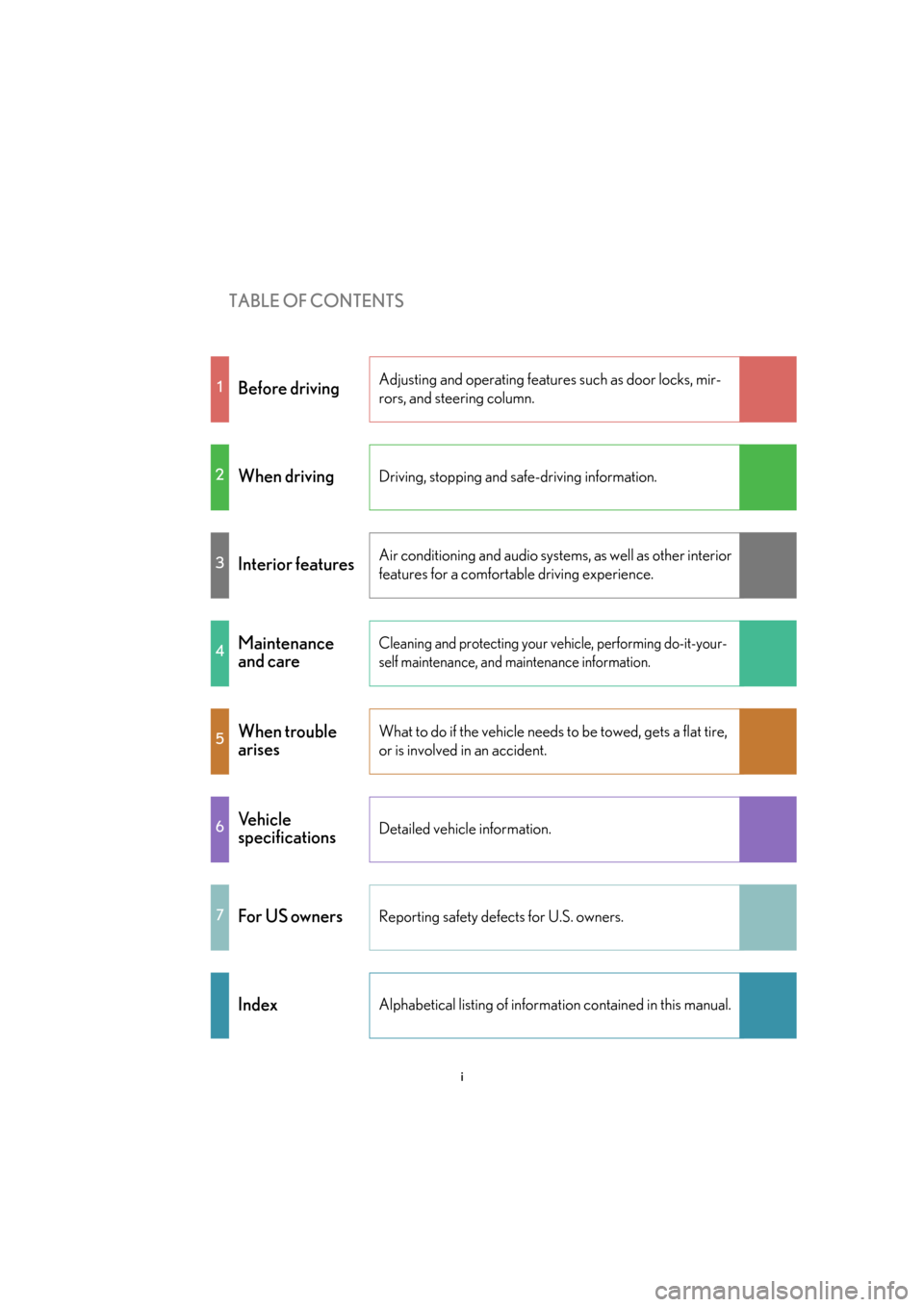
TABLE OF CONTENTS
i
1Before drivingAdjusting and operating features such as door locks, mir-
rors, and steering column.
2When drivingDriving, stopping and safe-driving information.
3Interior featuresAir conditioning and audio systems, as well as other interior
features for a comfortable driving experience.
4Maintenance
and careCleaning and protecting your vehicle, performing do-it-your-
self maintenance, and maintenance information.
5When trouble
arisesWhat to do if the vehicle needs to be towed, gets a flat tire,
or is involved in an accident.
6Vehicle
specificationsDetailed vehicle information.
7For US ownersReporting safety defects for U.S. owners.
IndexAlphabetical listing of informat ion contained in this manual.
Page 3 of 548
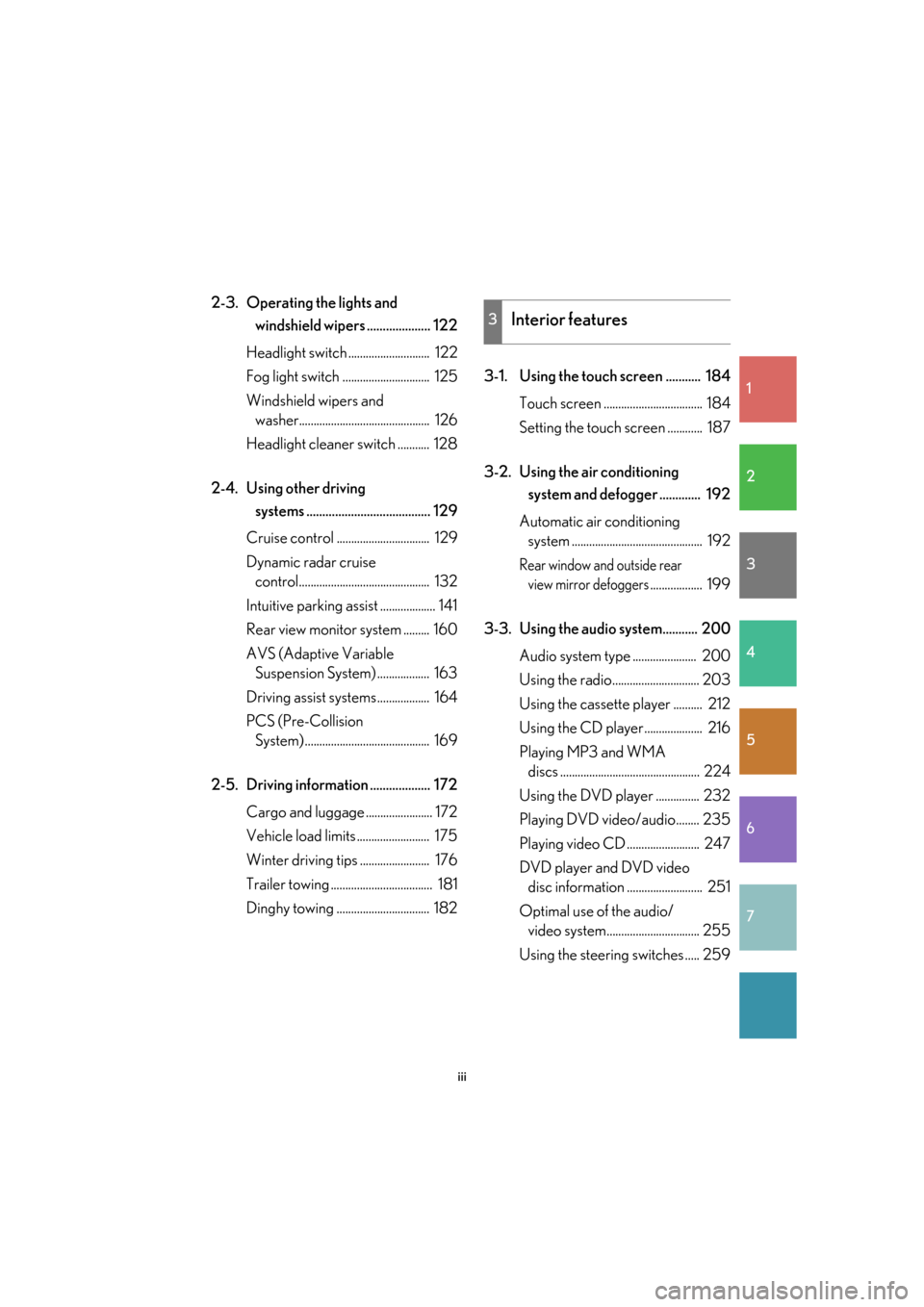
1
2
3
4
5
6
7
iii
2-3. Operating the lights and
windshield wipers .................... 122
Headlight switch ............................ 122
Fog light switch .............................. 125
Windshield wipers and
washer............................................. 126
Headlight cleaner switch ........... 128
2-4. Using other driving
systems ....................................... 129
Cruise control ................................ 129
Dynamic radar cruise
control............................................. 132
Intuitive parking assist ................... 141
Rear view monitor system ......... 160
AVS (Adaptive Variable
Suspension System) .................. 163
Driving assist systems.................. 164
PCS (Pre-Collision
System) ........................................... 169
2-5. Driving information ................... 172 Cargo and luggage ....................... 172
Vehicle load limits ......................... 175
Winter driving tips ........................ 176
Trailer towing ................................... 181
Dinghy towing ................................ 182 3-1. Using the touch screen ........... 184
Touch screen .................................. 184
Setting the touch screen ............ 187
3-2. Using the air conditioning
system and defogger ............. 192
Automatic air conditioning
system ............................................. 192
Rear window and outside rear
view mirror defoggers.................. 199
3-3. Using the audio system........... 200 Audio system type ...................... 200
Using the radio.............................. 203
Using the cassette player .......... 212
Using the CD player.................... 216
Playing MP3 and WMA
discs ................................................ 224
Using the DVD player ............... 232
Playing DVD video/audio........ 235
Playing video CD ......................... 247
DVD player and DVD video
disc information .......................... 251
Optimal use of the audio/
video system................................ 255
Using the steering switches ..... 259
3Interior features
Page 5 of 548

1
2
3
4
5
6
7
v
5-1. Essential information .............. 428If your vehicle needs to be
towed.............................................. 428
If you think something is
wrong ............................................. 435
Event data recorder .................... 436
5-2. Steps to take in an
emergency .............................. 438
If a warning light turns on or a
warning buzzer sounds............... 438
If a warning message is
displayed....................................... 444
If you have a flat tire (Vehicles
with run-flat tires) ...................... 460
If you have a flat tire (Vehicles
with standard tires) .................... 461
If the hybrid system will not
start .................................................. 471
If the shift lever cannot be
shifted from P .............................. 472
If you lose your keys .................... 473
When the electronic key
battery is discharged ............... 474
If the 12 volt battery is
discharged ................................... 476
If your vehicle overheats .......... 480
If the vehicle becomes
stuck............................................... 483 6-1. Specifications............................ 486
Maintenance data ........................ 486
Fuel information ............................ 495
Tire information ........................... 498
6-2. Customization ........................... 510 Customizable features ............... 510
6-3. Initialization ................................ 514 Items to initialize ............................ 514
Reporting safety defects for
U.S. owners................................... 516
Alphabetical index.................... 518
What to do if............................... 526
5When trouble arises6Vehicle specifications
7For US owners
Index
Page 30 of 548
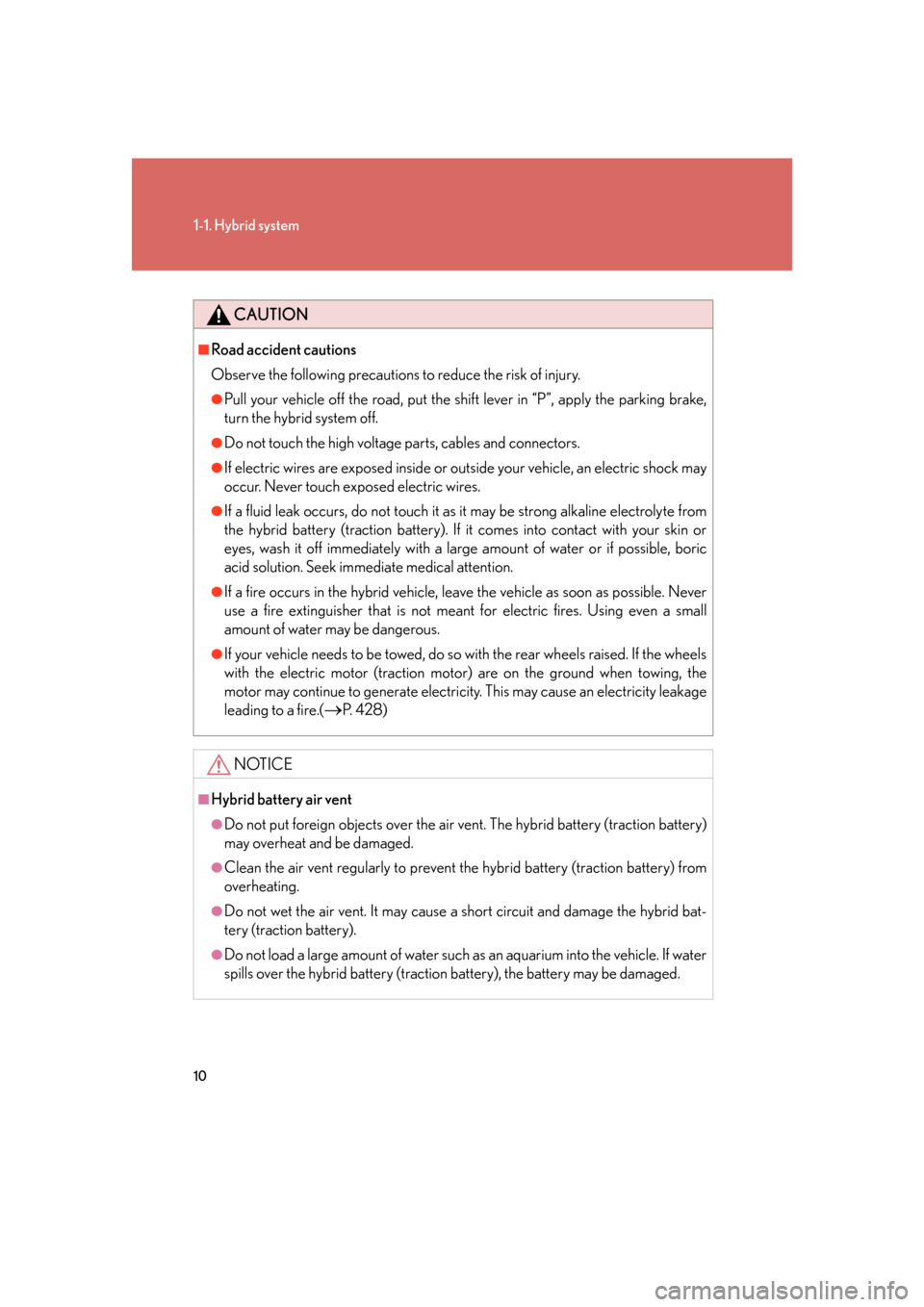
10
1-1. Hybrid system
CAUTION
■Road accident cautions
Observe the following precautions to reduce the risk of injury.
●Pull your vehicle off the road, put the shift lever in “P”, apply the parking brake,
turn the hybrid system off.
●Do not touch the high voltage parts, cables and connectors.
●If electric wires are exposed inside or outside your vehicle, an electric shock may
occur. Never touch exposed electric wires.
●If a fluid leak occurs, do not touch it as it may be strong alkaline electrolyte from
the hybrid battery (traction battery). If it comes into contact with your skin or
eyes, wash it off immediately with a large amount of water or if possible, boric
acid solution. Seek immediate medical attention.
●If a fire occurs in the hybrid vehicle, le ave the vehicle as soon as possible. Never
use a fire extinguisher that is not meant for electric fires. Using even a small
amount of water may be dangerous.
●If your vehicle needs to be towed, do so with the rear wheels raised. If the wheels
with the electric motor (t raction motor) are on the ground when towing, the
motor may continue to generate electricit y. This may cause an electricity leakage
leading to a fire.(
P. 4 2 8 )
NOTICE
■Hybrid battery air vent
●Do not put foreign objects over the air vent. The hybrid battery (traction battery)
may overheat and be damaged.
●Clean the air vent regularly to prevent th e hybrid battery (traction battery) from
overheating.
●Do not wet the air vent. It may cause a short circuit and damage the hybrid bat-
tery (traction battery).
●Do not load a large amount of water such as an aquarium into the vehicle. If water
spills over the hybrid battery (tractio n battery), the battery may be damaged.
Page 35 of 548

15
1-3. Opening, closing and locking the doors and trunk
1
Before driving
Antenna locationAntennas outside cabin
Antennas inside cabin
Antenna outside trunk
Antenna inside trunk
■Operation signals
A buzzer sounds and the emergency flashers flash to indicate that the doors have
been locked/unlocked. (Locked: Once; Unlocked: Twice)
■Conditions affecting operation
The smart access system with push-button start and wireless remote control func-
tion may not operate normally in the following situations.
●Near a TV tower, radio station, electric power plant, airport or other facility that
generates strong radio waves
●When carrying a portable radio, cellular phone or other wireless communica-
tion device
●When multiple electronic keys are in the vicinity
●When the electronic key has come into contact with, or is covered by a metallic
object
●When a wireless key (that emits radio waves) is being used nearby
●When the electronic key has been left ne ar an electrical appliance such as a
personal computer
In these situations, remove all possible caus e of malfunction, or follow the steps out-
lined in “When the electronic key battery is discharged”. ( P. 4 74 )
Page 59 of 548

39
1-4. Adjustable components
1
Before driving
■Adjusting the height of the driver’s head restraint manually
■Removing the driver’s seat head restraint
For removal and installation, ask your Lexus dealer.
■Adjusting the height of the head restraints
■Adjusting the center rear seat head restraint
Always raise the head restraint one level from the stowed position when using.
■Head restraints of different seats
The head restraints are specially designed for the seats on which they are installed.
CAUTION
■Head restraint precautions
Observe the following precautions regarding the head restraints. Failure to do so
may result in death or serious injury.
●Adjust the head restraints to the correct position at all times.
●Do not drive with the head restraints removed.
Push and hold the lock release button when
lowering or raising the head restraint.
Make sure that the head restraints are
adjusted so that the center of the head
restraint is closest to the top of your ears.
Page 66 of 548
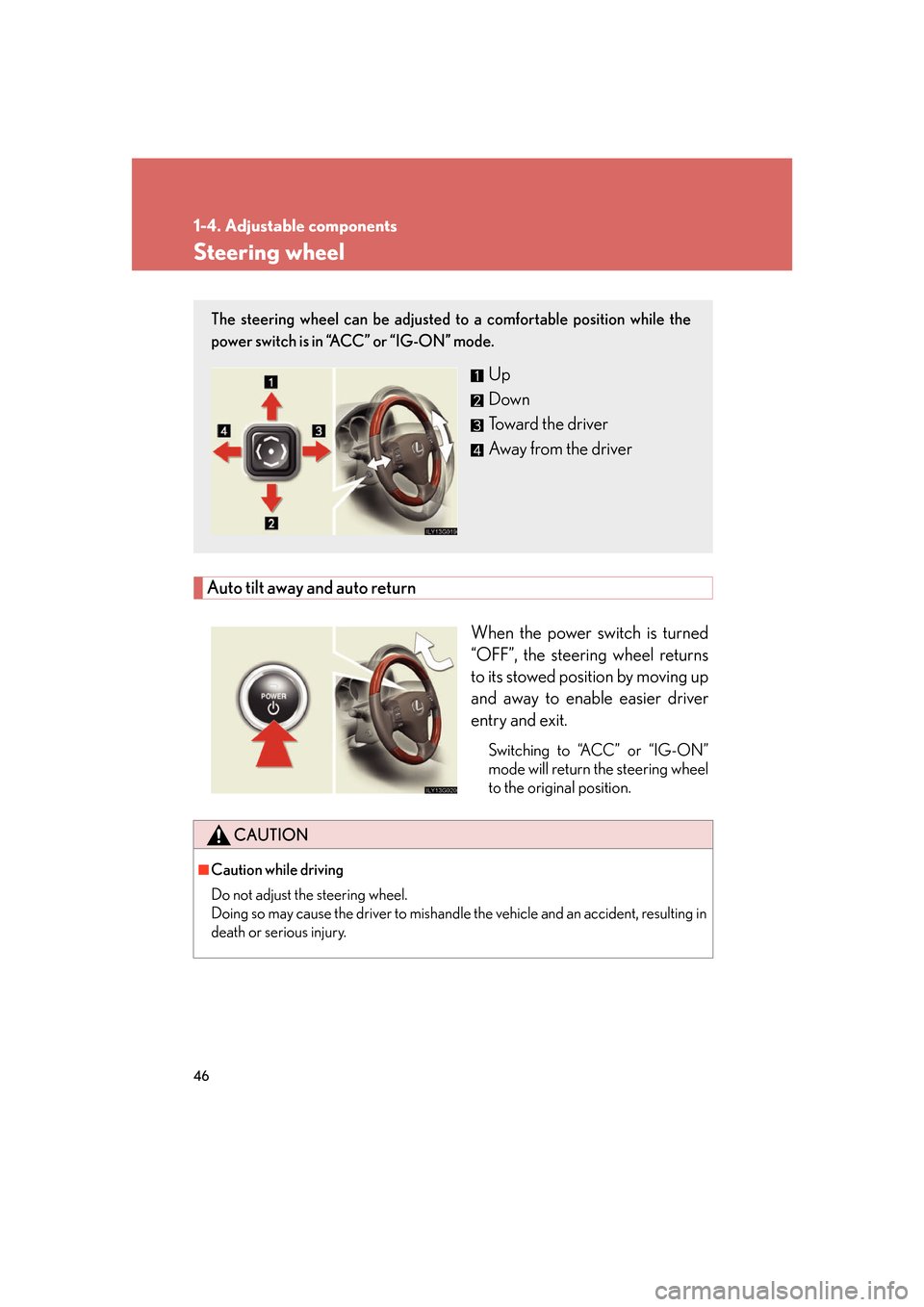
46
1-4. Adjustable components
Steering wheel
Auto tilt away and auto returnWhen the power switch is turned
“OFF”, the steering wheel returns
to its stowed position by moving up
and away to enable easier driver
entry and exit.
Switching to “ACC” or “IG-ON”
mode will return the steering wheel
to the original position.
The steering wheel can be adjusted to a comfortable position while the
power switch is in “ACC” or “IG-ON” mode.
Up
Down
Toward the driver
Away from the driver
CAUTION
■Caution while driving
Do not adjust th e steering wheel.
Doing so may cause the driver to mishandle the vehicle and an accident, resulting in
death or serious injury.
Page 92 of 548

72
1-8. Safety information
CAUTION
■SRS airbag precautions
Observe the following precautions regarding the airbags. Failure to do so may
cause death or serious injury.
●The driver and all passengers in the vehicle must wear their seat belts properly.
The SRS airbags are supplemental devices to be used with the seat belts.
●The SRS driver airbag deploys with considerable force, and can cause death or
serious injury especially if the driver is very close to the airbag. The National
Highway Traffic Safety Administration (“NHTSA”) advises:
Since the risk zone for driver airbag is th e first 2 - 3 in. (50 - 75 mm) of inflation,
placing yourself 10 in. (250 mm) from your driver airbag provides you with a
clear margin of safety. This distance is measured from the center of the steering
wheel to your breastbone. If you sit less than 10 in. (250 mm) away now, you can
change your driving position in several ways:
• Move your seat to the rear as far as you can while still reaching the pedals
comfortably.
• Slightly recline the back of the seat. Al though vehicle designs vary, many driv-
ers can achieve the 10 in. (250 mm) distan ce, even with the driver seat all the
way forward, simply by reclining the back of the seat somewhat. If reclining
the back of your seat makes it hard to see the road, raise yourself by using a
firm, non-slippery cushion, or raise the seat if your vehicle has that feature.
• If your steering wheel is adjustable, ti lt it downward. This points the airbag
toward your chest instead of your head and neck.
The seat should be adjusted as recommended by NHTSA above, while still main-
taining control of the foot pedals, steering wheel, and your view of the instrument
panel controls.
Page 94 of 548

74
1-8. Safety information
CAUTION
■SRS airbag precautions
●Do not sit on the edge of the seat or lean
against the dashboard.
●Do not allow a child to sit on the knees of a
front passenger while the vehicle is moving.
●Do not drive the vehicle while the driver or
passenger have items resting on their
knees.
●Do not lean against the door, the roof side
rail or the front, side and rear pillars.
●Do not allow anyone to kneel on the front
passenger seat toward the door or put their
head or hands outside the vehicle.
Page 115 of 548
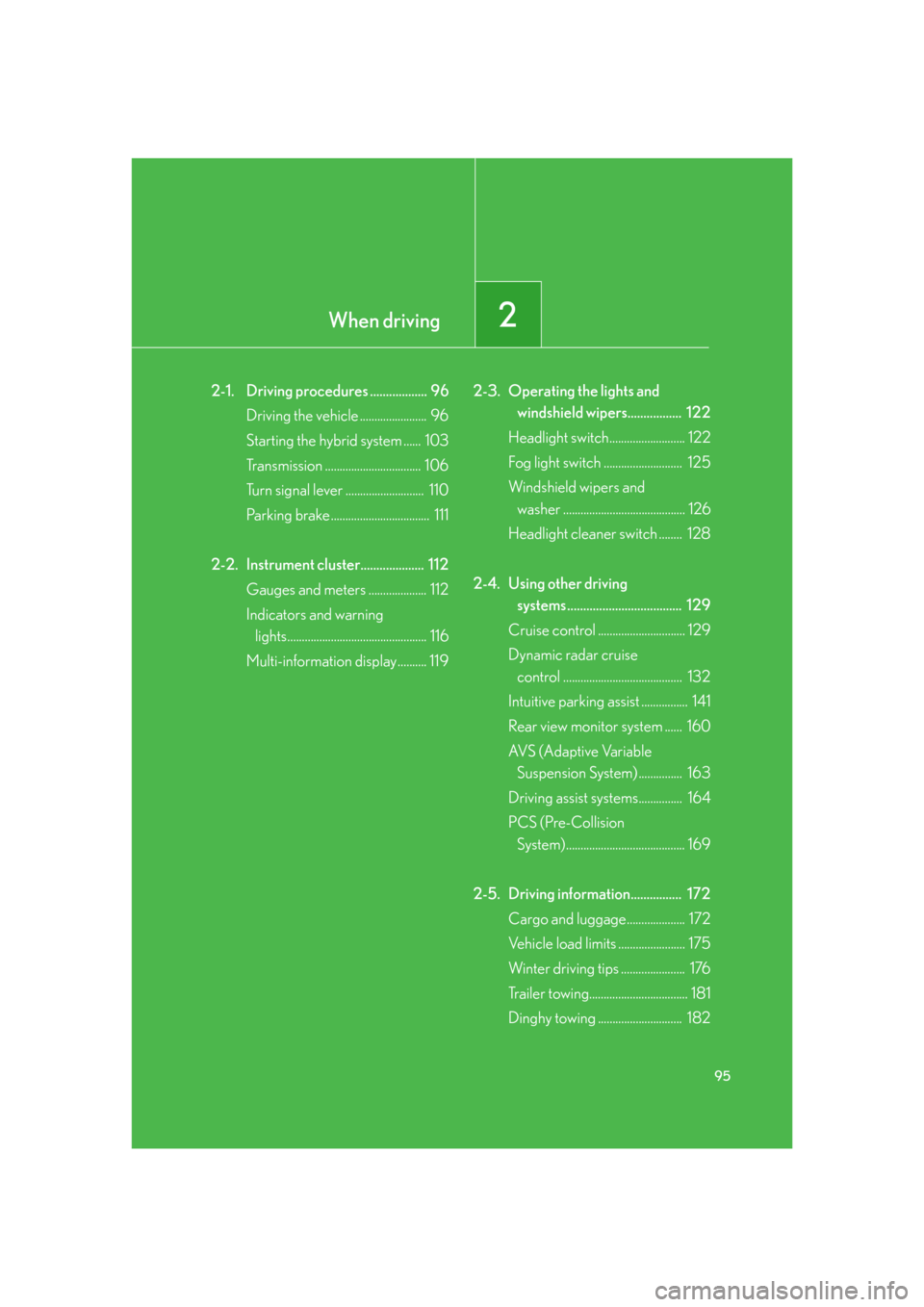
When driving2
95
2-1. Driving procedures .................. 96Driving the vehicle ....................... 96
Starting the hybrid system ...... 103
Transmission ................................. 106
Turn signal lever ........................... 110
Parking brake .................................. 111
2-2. Instrument cluster.................... 112 Gauges and meters .................... 112
Indicators and warning
lights................................................ 116
Multi-information display.......... 119 2-3. Operating the lights and
windshield wipers................. 122
Headlight switch.......................... 122
Fog light switch ........................... 125
Windshield wipers and
washer .......................................... 126
Headlight cleaner switch ........ 128
2-4. Using other driving
systems .................................... 129
Cruise control .............................. 129
Dynamic radar cruise
control ......................................... 132
Intuitive parking assist ................ 141
Rear view monitor system ...... 160
AVS (Adaptive Variable
Suspension System) ............... 163
Driving assist systems............... 164
PCS (Pre-Collision
System)......................................... 169
2-5. Driving information................ 172 Cargo and luggage.................... 172
Vehicle load limits ....................... 175
Winter driving tips ...................... 176
Trailer towing.................................. 181
Dinghy towing ............................. 182